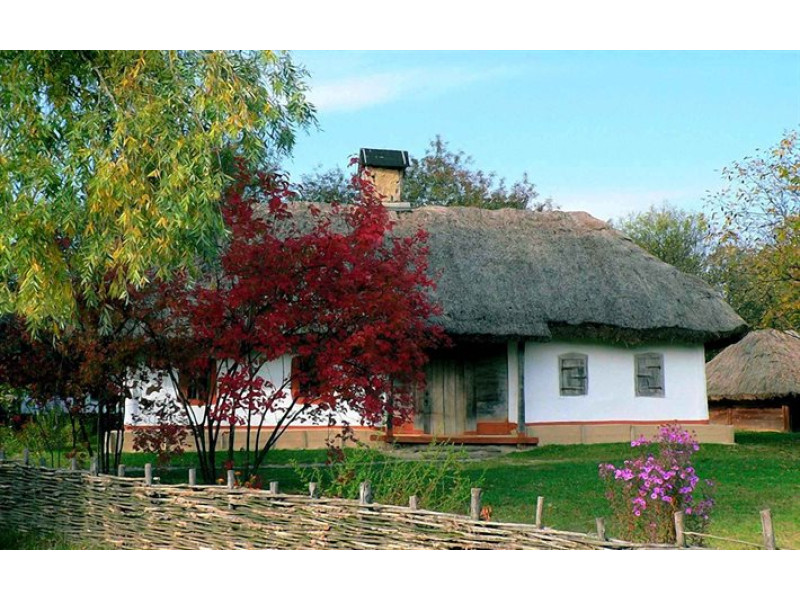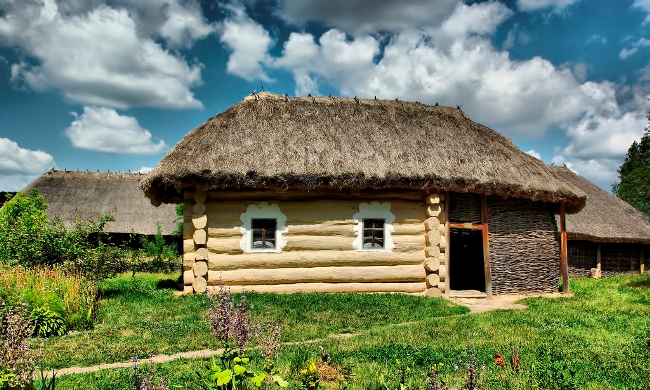What is a Ukrainian hut? It is a cozy dwelling, usually whitewashed inside and out, covered with a thatched roof, often decorated with patterns and paintings on the outside, and richly decorated with textiles on the inside. Its shape is elongated, which is due to the arrangement of the rooms in it: hut-shelter, hut-shelter-hut or hut-shelter-pantry. The living space itself is close to the shape of a square.
Externally, the Ukrainian hut looked in such a way as to emphasize the tastes, character, and peculiarities of the peasant. But on the other hand, the hut had to reflect the uniqueness and originality of the place where it was located, of the land that was native to it and its owner. The traditions of the hut personify the creative talent of the Ukrainian people, their vision of the world, their experience, and their artistic and aesthetic taste.
When choosing a place for a hut, many factors had to be taken into account. This included the struggle with the elemental forces of nature, the intention to appease the land and nature, and the desire to make the hut a reliable and safe center. All this was deeply reflected in the archaic beliefs, rituals, and customs that were associated with the process of choosing a place for construction, the time when the foundation of the hut should be laid, when and how construction was completed, and how people moved into a new home.
The beginning of the construction of a new hut in a new estate was accompanied by a number of rituals and ceremonies. It was especially important to choose the right place for the new hut - because everything else depended on this factor.
There were prohibitions on the location of a new building. For example, it was not possible to build on land where a road had previously passed, where someone had previously been killed or maimed, or where a house had been burned by lightning. An unclean place, that is, a place where, as people said, a ghost had been seen, was also considered an unclean place, that is, a place unsuitable for building. Suitable places for building, the so-called happy places, were those where cattle could lie down, where ants' paths passed - this was considered a symbol of fertility. When looking for such places, people sometimes resorted to fortune-telling, or independently conducted such searches to be sure of the correct location of the new house.
To determine the right place for construction, the inhabitants of Left-Bank Ukraine drove out their cattle and waited for them to graze and lie down. As soon as the cattle began to chew their cud and lay down peacefully, they marked the place as good for future construction.
If there was a desire to do fortune telling, the simplest way was this: a place for the house was determined, and in its corners the future owner would pour four small heaps of grain in the evening. In the morning he would check them, and if the grain was intact, the place was considered lucky. Bread could be used instead of grain.
Fortune-telling had to take place from evening to morning, it had its own sacred meaning. Demonology claimed that the most active activity of devils, witches, ghouls and other evil spirits was manifested precisely at night, therefore, they could be detected precisely at these hours. According to beliefs, it was believed that a beast, an unclean spirit or the devil himself could take bread precisely in an unclean place. And a clean place would not allow him to do this. Fortune-telling with water was also widespread: the owner marked four corners, four points. And in each of them he placed a jug of water. They were necessarily covered with wooden lids. In the morning, they looked at what was bewitched: if the water had started, such a place was considered unsuitable for a new building. Fortune-telling could also be combined, combining the types and elements indicated above. So, a little bread could also be left next to the jugs of water for the night.
The time of its foundation was also of great importance for a happy new building. Usually the best days for this were spring and summer. If you lay a hut on a new moon, then there will always be abundance in the hut. Among the most favorable days of the week were Tuesday, Thursday, Friday and Saturday. During the foundation of a hut, there was still a kind of archaic rite - the ransom. Once upon a time, in order to strengthen the hut, people made sacrifices, first human, then they were replaced with animals, animal skulls, and even later there were enough plants or small money. This was laid in the locks to the first crown of the new log house.
The main type of Ukrainian hut is considered to be the so-called "wide residential building", which is known to architects from Near Asia, the Caucasus, etc. It is a three-chamber structure, the entrance to which is located on the longer wall. All chambers are on the same line. From the street, the door leads to the central chamber, which is called the hall.
Compared to the Ukrainian hut, the "izby" of the inhabitants of central Russia were slightly larger in size. They had a gable roof and were most often made of logs. The hut of the Ukrainians was more similar in appearance to the residential buildings of the southwestern Slavs. Such huts were more characterized by the symmetrical arrangement of rooms, on both sides of the hallways. Sometimes the buildings were also located on one side. The hallways in the Czech Republic, for example, were even so-called warm: they had an open hearth, sometimes even a stove. Such warm hallways were also built by the Cossack elders.
We can find many descriptions of castles and fortresses in documents. Literature devoted to describing the features of architecture of certain periods mentions fortresses, city tenement houses, residences built in the palace type. But it is worth remembering that such buildings and complexes also included residential parts. They were very similar to village or suburban huts. In the first half of the 18th century, the dwellings of Cossack elders and wealthy townspeople or Cossacks differed little. Sources indicate that the basis of the people's dwellings was also the basis for the dwellings of richer people. Even the houses of elders and hetmans were simple. These huts usually consisted of two halves, one was a hall with rooms, in the middle there were halls. Each hall had four windows. The hut differed only in its appearance: there was a porch around the building, shutters, and there were attics above the stalls and storerooms.
Mass folk rural construction was almost indistinguishable from wealthy structures – neither in the shape of the roof, nor in the structural details and their decorative design.
We find a description of one of the rather interesting noble courtyards of the 1970s in Volyn. The local residential building had two rooms and a pantry. A separate pantry was built in the courtyard where the servants lived, and there was also a hut with awnings.
According to written sources, one can also imagine the layout of the housing of that time (15th-17th centuries). The description of Lutsk Castle (1552) mentions two huts that stood side by side. There were no porches between them, but a pantry was attached to one of them. We find a description of Buremlya Castle (1573), which contains information about such housing, which consisted of two huts and one porch. A separate room was allocated in the porch, under which a cellar was located. The document of the Zhytomyr Starostvo (1662) tells about a hut based on the principle of hut+porch+pantry. One of the courtyards near Volodymyr (1590) is described in its inventory as a large house, covered with shingles on top, and the structure was hut+porch+hut+pantry. In addition, the castle had a small house, which also consisted of a hut, a hall, and a storeroom. So we see that the housing scheme "hut+hall+hut" and "hut+hut+hall (storeroom)" was already known from the 15th-17th centuries.
There is an assumption that it was at this time that the further development of housing planning skills took place. For example, this includes two huts side by side, the construction of a hut with a closet or a vankyr, the allocation of a separate room in the hallway. The emergence of additional rooms above the floor wall in the dwelling is very important. After all, until recently, the emergence of such rooms was considered a consequence of dividing the hut across. Such a plan was already very widespread in the Carpathians at the beginning of the 17th century. among the petty nobility, as indicated by archival and ethnographic materials. As for the constructive plan, these were five-walled log cabins, which at that time served as the basis of residential and household buildings.
In recent years, archaeological data has confirmed their ancient Ukrainian origin. In the cages, arranged directly in the defensive structures, together with their families lived the druzhinniki, military settlers from various settlements, fortresses, feudal castles of Kievan Rus, later the Galicia-Volyn principality. In the transverse direction, such external cages were slightly narrower, they were used as storage facilities. They lived in the internal, wider, cages.
Monuments of folk architecture that have survived to our times recall many archaic elements, such as plows, for example - high, up to 5 meters, pillars, forked at the top.
Such poles were dug into the ground, a log or beam was placed in the top of the ridge, and “klyuchyny” (poles with knots) were hung on them. Later, rafters were hung on them, which were combined in pairs, and the entire roof plane rested on them. Such plyushki took on most of the weight of the roof, thus reducing the load on the walls. In southern Ukraine, such a bipod structure can still be seen in local dugout huts. There was no ceiling in such houses, and the entire structure – plyushki, klyuchyny and rafters – could be seen from the inside.
Very little information has been preserved about the housing of the 15th-17th centuries. For example, when describing the castles of Skala and Smotrych, it was indicated that the living rooms and stoves were whitewashed. If the housing was heated in black, then servants lived in it. This proves to us that the rural housing of that time was dusty.
At different times, various travelers visited Ukraine, and in their reports you can also find many interesting descriptions. For example, the description of the Swedish ambassador K. Hildebrandt (traveled through Ukraine in 1656-1657), which says: in the hut there was a very large stove, on which they baked or cooked, and on top of it, children and servants slept on sheepskins. The owner and the hostess slept on a couch that was slightly raised above the floor.
Huts in Ukraine are almost everywhere whitewashed. The exceptions are some areas of Polissya and the Carpathians. Such white walls go very well with the roof - usually straw gray or wooden. The inside of the huts were also whitewashed, and they were neatly painted with clay (and colored ones), and there were carvings, flowers, and dried herbs everywhere, which gave the hut its aroma and color. Johann Georg Kohl, a German geographer, traveling through Ukraine in 1838, noticed that Ukrainians live in clean, well-groomed huts that seem to smile at people. If the Dutch wash their huts before every Sunday, then Ukrainians whitewash them twice a month. So their huts look like clean, freshly bleached canvas.
The Ukrainian hut was an architectural object, and also performed an aesthetic and symbolic function. It was possible, for example, to determine the level of prosperity, wealth, and generally the preferences of its owner. If the hut was conveniently located, this also indicated that the owner valued and respected folk customs, rituals, and ceremonies. If the hut had a cleanly installed chimney, clean, neat windows, and walls, this indicated the presence of a good, tidy housewife in the hut.
So we can see that the hut is a kind of embodiment of the Ukrainian mentality, one of the forms of its modern spirituality. As consciousness was formed, the hut went from a symbol, a syncretic representation, through an image, a sign, and in the last century it was formed as an idea, a certain aesthetic criterion, an indicator of worldview and world perception.
Our ancestors have long been afraid of evil spirits, they were no less harmful and dangerous than material enemies or predatory animals. Therefore, every Ukrainian tried to protect his home as best he could. It was fortified, turning it into a fortress, or "protected". The word "temple" takes its place next to the word "shrine", "Mansions", that is, it indicates the sacredness of the structure from the point of view of the consciousness of the 13th-17th centuries. Huts were filled with amulets, magical signs and objects. A special interior design of the home played a big role. Openings were decorated - windows, chimneys, doors, because they were the ones that could let evil spirits through. Thus, the entire house became a magical-practical amulet, in which each thing had its own value and meaning. And the entire house turned into a center of well-being, a hiding place of comfort, happiness and security.
In the national consciousness of a Ukrainian, a hut is not just a place to live, but his own, native, his own corner. Every owner is the master in his hut. His own dwelling gives space for actions, it accepts a person no matter who he is. Therefore, the owner perceives it as his own, close to his heart. This is also reflected in folk songs. Hut, Mother, Homeland - these words form a single semantic series, they are filled with a single idea and a deep sense of their truth and strength. This turns a hut from an ordinary dwelling into a symbol that occupies an important place in the consciousness of the Ukrainian people.












Write a comment